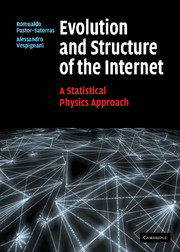Book contents
- Frontmatter
- Contents
- Preface
- List of abbreviations
- 1 A brief history of the Internet
- 2 How the Internet works
- 3 Measuring the global Internet
- 4 The Internet's large-scale topology
- 5 Modeling the Internet
- 6 Internet robustness
- 7 Virtual and social networks in the Internet
- 8 Searching and walking on the Internet
- 9 Epidemics in the Internet
- 10 Beyond the Internet's skeleton: traffic and global performance
- 11 Outlook
- Appendix 1 Graph theory applied to topology analysis
- Appendix 2 Interface resolution and router topology
- Appendix 3 Numerical analysis of heavy tailed distributions
- Appendix 4 Degree correlations
- Appendix 5 Scale-free networks: scaling relations
- Appendix 6 The SIR model of virus propagation
- References
- Index
1 - A brief history of the Internet
Published online by Cambridge University Press: 12 January 2010
- Frontmatter
- Contents
- Preface
- List of abbreviations
- 1 A brief history of the Internet
- 2 How the Internet works
- 3 Measuring the global Internet
- 4 The Internet's large-scale topology
- 5 Modeling the Internet
- 6 Internet robustness
- 7 Virtual and social networks in the Internet
- 8 Searching and walking on the Internet
- 9 Epidemics in the Internet
- 10 Beyond the Internet's skeleton: traffic and global performance
- 11 Outlook
- Appendix 1 Graph theory applied to topology analysis
- Appendix 2 Interface resolution and router topology
- Appendix 3 Numerical analysis of heavy tailed distributions
- Appendix 4 Degree correlations
- Appendix 5 Scale-free networks: scaling relations
- Appendix 6 The SIR model of virus propagation
- References
- Index
Summary
The Internet is the result of the bold effort of a group of people in the 1960s, who foresaw the great potential of a computer-based communication system to share scientific and research information. While in the early times it was not a user-friendly environment and was only used by a restricted community of computer experts and scientists, nowadays the Internet connects more than one hundred million hosts and keeps growing at a pace unknown in any other communication media. From this perspective, the Internet can be considered as one of the most representative accomplishments of sustained investment in research at both the basic and applied science levels.
The success of the Internet is due to its world-wide broadcasting capability that allows the interaction between individuals without regard for geographic location and distance. The information exchanged between computers is divided into data packets and sent to special devices, called routers, that transfer the packets across the Internet's different networks. Of course a router is not linked to every other router. It just decides on the direction the data packets take. In order to work reliably on a global scale, such a network of networks must be very slightly affected by local or even extensive failures in the network's nodes. This means that if a site is not working properly or it is too slow, data packets can be rerouted, on the spot, somewhere else.
- Type
- Chapter
- Information
- Evolution and Structure of the InternetA Statistical Physics Approach, pp. 1 - 9Publisher: Cambridge University PressPrint publication year: 2004



